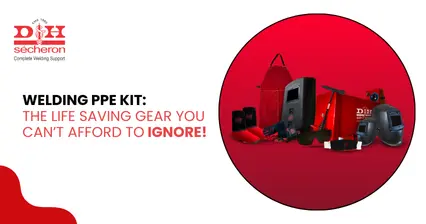SMAW vs. SAW - Unveiling the Key Differences
When it comes to welding processes, there are various techniques available to achieve strong and reliable bonds between metals. Two commonly used methods are Shielded Metal Arc Welding (SMAW) and Submerged Arc Welding (SAW). While both techniques have their own merits, understanding the differences between SMAW and SAW welding can help you choose the right method for your specific welding needs.
Process:
In SMAW (also known as stick welding), an electrode with a flux coating is manually operated to create an arc between the electrode and the workpiece. The heat generated by the arc melts the electrode, forming a weld pool that solidifies to create the joint.
On the other hand, in SAW, a continuous wire electrode is fed mechanically into the welding zone, while a granular flux is poured over the weld area to create a protective blanket. The arc is completely submerged beneath the flux, hence the name "submerged arc welding."
Usage:
While SMAW is known for its portability and ability to work in various positions, making it a popular choice for on-site welding projects. It is one of the oldest and most versatile welding processes, widely used in industries ranging from construction to fabrication.
SAW is often used for long, straight welds on thick materials and is particularly effective for high-production welding.
Level of Automation:
SMAW requires skilled operators to control the electrode and maintain the arc manually. This manual control provides a level of precision and adaptability but can be more time-consuming and less efficient for large-scale projects.
SAW, on the other hand, can be easily automated, allowing for continuous, high-speed welding with minimal operator intervention making SAW ideal for high-volume production lines where speed and consistency are crucial.
Quality of Welds:
SAW generally produces cleaner and more uniform welds compared to SMAW. The submerged arc and the granular flux shield the arc from impurities in the atmosphere, resulting in minimal spatter and a well-protected weld pool. This makes SAW highly suitable for applications where weld appearance and quality are critical, such as pressure vessel fabrication and pipe welding.
Heat Input:
The heat input during the welding process varies between SMAW welding and SAW welding .
SMAW tends to generate higher heat, leading to a smaller heat-affected zone (HAZ). While this can be advantageous for certain materials, it may also increase the risk of distortion and heat-related issues.
SAW, on the other hand, has a lower heat input, resulting in a larger HAZ. This reduced heat input minimizes distortion and can be beneficial when welding heat-sensitive materials.
Conclusion:
SMAW and SAW welding processes have distinct characteristics that cater to different welding requirements. SMAW offers versatility, portability, and the ability to work in various positions. On the other hand, SAW provides higher efficiency, cleaner welds, and excellent automation capabilities. Selecting the right welding method depends on factors such as the project scale, material properties, and desired weld quality.
Whether you opt for SMAW or SAW, it is crucial to consider the specific needs of your welding project. At D&H Secheron, we guide you with the key differences between these techniques, so that you can make an informed decision and achieve successful welds that meet your expectations.
15 May 2025 | Welding
An In-Depth Exploration of Low-Alloy Steel: Your Comprehensive Guide
15 May 2025 | Welding
Nagpur - Bori - Tuljapur Road MSH-3 in Yavatmal District (Maharashtra)
15 May 2025 | Welding
Guidelines to Understand Gas Welding: Applications, Advantages & Disadvantages
15 May 2025 | Welding
3 Tips for Finding the Best Mild Steel Electrode for Your Application
15 May 2025 | Welding
How to Select the Right Welding Filler Wires for Stainless Steel Welding?
15 May 2025 | Welding
Building the Narendra Modi Stadium with Norma V and Autotherme-1 Electrodes
15 May 2025 | Welding
Low Alloy Steel Welding in a (PEB) Pre Engineered Building Structure
15 May 2025 | Welding
Welding Rods: Different Types and Tips for Properly Storing and Handling
15 May 2025 | Welding
Tips for Flawless Welds with Stainless Steel Electrodes: Pros and Cons
15 May 2025 | Welding
Exploring Applications and Benefits of Stainless Steel Welding Electrodes
15 May 2025 | Welding
Welding Basics: Joining Metals with Heat and Pressure - A Beginners Guide
15 May 2025 | Welding
Distinguishing Low-Alloy Steel from High-Alloy Steel: Understanding the Variations
15 May 2025 | Welding
Hard Facing Wire - Understanding the Process and Achieving Optimal Result
15 May 2025 | Welding
Exploring the Advantages of Stainless Steel Electrodes in Welding Applications
15 May 2025 | Welding
Weathering Steel vs. Traditional Steel: A Comparative Analysis of Performance
15 May 2025 | Welding
Choosing the Right Welding Rod: Why 6013 Electrodes Might Be Your Ideal Option
15 May 2025 | Welding
Why 7018 Electrodes Are Preferred for High-Strength Welds in Pipeline Construction
15 May 2025 | Welding
Filler Wire vs. Stainless Steel Filler Wire: Understanding the Key Differences
15 May 2025 | Welding
Exploring the Impact of Filler Material on Welding Quality and Durability
15 May 2025 | Welding
Choosing the Right Cast Iron Electrode for Different Welding Projects
15 May 2025 | Welding
Top Advantages of Cast Iron Electrodes for Industrial Welding Applications
15 May 2025 | Welding
Key Benefits and Challenges of Using TIG Welding in Industrial Projects
15 May 2025 | Welding
5 Reasons Why 7018 Electrode is the Gold Standard for Welding Professionals
15 May 2025 | Welding
Top 5 Advantages of Flux Cored Arc Welding for Heavy-Duty Applications.png)
15 May 2025 | Welding
Lotherme-601: A Game-Changer for Restoring Shoulder Pins in Heavy Machinery
15 May 2025 | Welding
How D&H Sécheron Helped Repair a Rotary Kiln’s Cooler Section with LoTherme 352
15 May 2025 | Welding
Piston Repair for Mining Industry: Cost-Effective Solutions with LoTherme 468.webp)






.jpg)







































.jpg)
.jpg)

.jpg)

.jpg)





.jpg)
.jpg)
.jpg)



.webp)
.jpg)
.jpg)
.webp)
.jpg)






















.png)



.webp)

.webp)
.webp)



